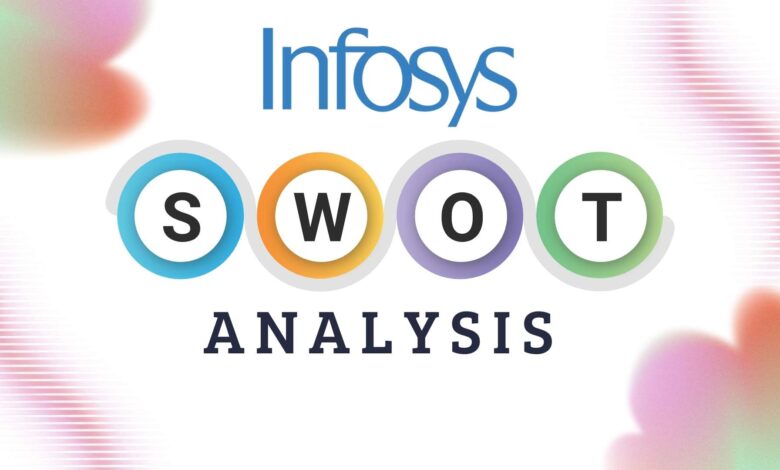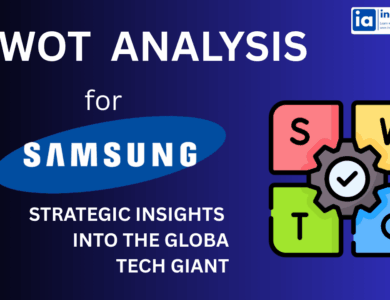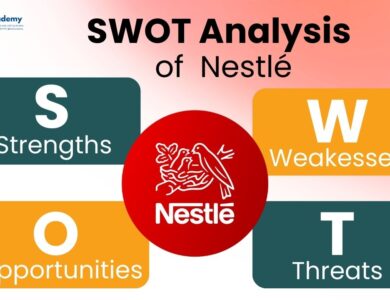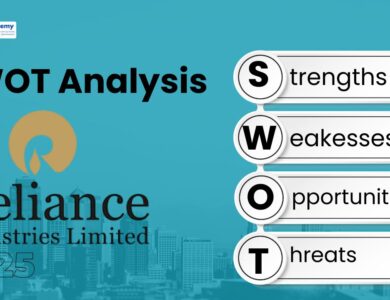SWOT Analysis of Infosys (2025): Strategic Review of India’s Global IT Consulting Leader
Explore the complete SWOT analysis of Infosys in 2025. Discover its strengths, challenges, growth opportunities, and global threats as it competes in a rapidly evolving IT and digital services landscape.

When you hear the term “India’s global IT brand,” Infosys is likely one of the first names that comes to mind. With operations in over 50 countries and clients ranging from Fortune 500 companies to government agencies, Infosys has become a trusted digital transformation partner worldwide.
But 2025 is not business as usual.
With the rise of AI-driven automation, cloud-native platforms, and shifting economic headwinds, IT companies—no matter how big—must stay agile, relevant, and innovation-ready. That’s where a SWOT analysis of Infosys becomes especially important.
In this article, we’ll break down Infosys’s Strengths, Weaknesses, Opportunities, and Threats, giving you a strategic snapshot of how this Bengaluru-born tech giant is adapting and competing in a rapidly evolving global IT landscape.
Let’s begin with a quick overview of Infosys’s global journey.
Also read: Complete SWOT Analysis of Bajaj – From Two-Wheelers to Global Exports
Learn AI & Digital Marketing,
Pay Fees After Placement
- ✅ Minimal Admission Fees
- ✅ No Loan or Income Sharing Agreement
- ✅ 100% Placement Support
- ✅ ISO & Govt Registered Certificate
- ✅ Practical 3+1 Months Duration
Get a free counseling call. We’ll guide you through learning, certification, and job placement.
Request a Free Call Back
Takes less than a minute.
Company Overview of Infosys
Infosys Limited, founded in 1981 by seven engineers in Pune, is now a globally recognized leader in IT services and digital consulting.
Headquartered in Bengaluru, Infosys serves enterprises across industries with technology-driven solutions that enable agility, scalability, and transformation.
As of 2025:
-
Revenue (FY24–25): Over $20 billion USD
-
Market Cap: ~$90 billion USD
-
Employee Strength: 345,000+ professionals across 50+ countries
-
Core Services: Digital transformation, AI & automation, cloud computing, cybersecurity, consulting, and IT outsourcing
-
Key Clients: Fortune 500 companies in banking, healthcare, retail, manufacturing, and telecom
Infosys is also known for its strong commitment to corporate governance, sustainability, and employee skilling through platforms like Infosys Lex and Springboard.
Whether it’s managing mission-critical banking platforms or helping manufacturers embrace Industry 4.0, Infosys has become a trusted name in technology-driven value creation.
What is a SWOT Analysis?
A SWOT analysis is a powerful framework used to evaluate a company’s strategic standing by breaking down its:
-
Strengths – Internal capabilities and competitive advantages
-
Weaknesses – Internal limitations or gaps
-
Opportunities – External trends the company can capitalize on
-
Threats – External risks that may impact growth or profitability
For a global tech giant like Infosys, a SWOT analysis helps assess how well the company is navigating shifts in the IT services ecosystem—from cloud migration and AI adoption to economic headwinds and talent disruption.
In a rapidly changing industry, knowing where you stand isn’t optional—it’s mission-critical.
Also read: Complete SWOT Analysis of Bajaj – From Two-Wheelers to Global Exports
Strengths of Infosys
Infosys has built a reputation that combines trust, global delivery excellence, and digital innovation. Its consistent execution and client-centric model have made it a preferred IT partner for some of the world’s largest enterprises.
Let’s explore the key strengths driving Infosys’s continued success in 2025:
1. Strong Global Brand & Client Trust
Infosys is one of the most recognized Indian brands globally, known for its ethics, transparency, and delivery capabilities. It has deep client relationships, many lasting over a decade.
In regions like North America and Europe, Infosys is seen not just as a vendor—but as a strategic digital partner.
2. Robust Digital & AI Capabilities
Infosys has heavily invested in AI, automation, cloud transformation, and cybersecurity. Its proprietary platforms like Infosys Cobalt (cloud), Topaz (AI), and Polycloud help deliver end-to-end solutions across industries.
This keeps Infosys relevant in high-value, tech-first deals.
3. Diversified Client Base
Infosys serves over 1,700 global clients across banking, insurance, manufacturing, telecom, retail, and life sciences. This industry spread provides insulation against downturns in any single vertical.
4. Strong Financials & Operational Efficiency
With operating margins of ~21%, zero long-term debt, and steady cash reserves, Infosys is financially strong. Its focus on high-value work over volume-driven projects also helps it stay profitable despite pricing pressure.
5. Talent Development & Retention Programs
Through learning platforms like Lex and Springboard, Infosys has created one of the strongest skilling ecosystems in the IT industry. This supports employee growth, retention, and reskilling in emerging tech.
Competitor Comparison Table – 2025 Snapshot
| Company | FY25 Revenue (USD) | Operating Margin | Employees | Key Strengths |
|---|---|---|---|---|
| Infosys | $20B+ | ~21% | 345,000+ | AI/Cloud focus, client trust, learning |
| TCS | $29B+ | ~24% | 620,000+ | Scale, BFSI dominance, global delivery |
| Accenture | $66B+ | ~15% | 740,000+ | Consulting, M&A, SaaS partnerships |
| Wipro | $11B+ | ~15% | 240,000+ | Diversified services, legacy clients |
Data based on public disclosures and FY24–25 estimates.
Weaknesses of Infosys
While Infosys enjoys a strong global reputation, it also faces some internal limitations that could impact its competitive edge—especially as the tech industry evolves faster than ever.
Let’s take a closer look at the key weaknesses Infosys needs to address:
1. High Revenue Dependence on North America
Nearly 60% of Infosys’s revenue comes from North America. While the region offers high-value contracts, this overexposure makes the company vulnerable to economic slowdowns, policy changes, or client spending cuts in the U.S. market.
2. Slower Product Innovation Compared to Global Peers
Infosys remains largely a services-driven company. Unlike product-focused peers (e.g., Salesforce, Oracle, or Adobe), Infosys has limited proprietary products—affecting scalability and valuation multiples in the long term.
3. Talent Attrition in Niche Skill Areas
Despite strong skilling programs, Infosys faces rising attrition—especially among high-demand talent in AI, data science, and cloud architecture. Startups and global product firms often offer more aggressive pay packages.
4. Lower Margins Compared to TCS
While Infosys is operationally sound, its margins (~21%) still lag behind TCS’s 24%, driven by differences in scale, deal structure, and automation maturity.
5. Limited Government & Public Sector Penetration
Infosys has historically focused on the private sector. Its presence in public sector transformation, defense, or large-scale national projects is relatively limited—especially compared to competitors like TCS or L&T.
While none of these are critical weaknesses, they are important gaps Infosys must close to sustain long-term leadership and future-proof its growth.
Opportunities for Infosys
The global IT industry is undergoing a transformation—and Infosys is well-positioned to ride the next wave of digital disruption. With strong fundamentals and deep client trust, it has multiple avenues to scale and innovate.
Here are the key opportunities Infosys can tap into in 2025 and beyond:
1. Boom in AI & Automation Services
With the rise of Generative AI, machine learning, and RPA, enterprises across sectors are looking for partners to help them implement these technologies securely and at scale.
Infosys’s Topaz AI suite and automation-first approach position it perfectly to lead in this domain.
2. Cloud Transformation Across Industries
Enterprises are moving from on-prem to multi-cloud and hybrid models, creating demand for deep expertise in AWS, Azure, and Google Cloud.
Infosys Cobalt—its full-stack cloud offering—can drive significant revenue growth as digital modernization accelerates globally.
3. Digital Spend in Emerging Markets
While Infosys has a stronghold in the West, Asia-Pacific, Africa, and Latin America are rapidly digitizing. Expanding delivery and consulting presence in these markets can unlock untapped growth.
4. Expansion into Healthcare, Sustainability & ESG Tech
From building digital patient platforms to green IT and carbon accounting software, new sectors present massive growth potential.
Infosys’s reputation in ethical tech and sustainability can help differentiate its offerings.
5. Strategic Acquisitions & Niche Tech Partnerships
Acquiring AI/ML startups, cloud-native SaaS firms, or cybersecurity platforms can enhance Infosys’s capabilities while opening doors to new IPs and fast-growing client bases.
6. Upskilling & Workforce Platform Monetization
Infosys Springboard and Lex are not just internal tools—they could become monetizable learning platforms, targeting global enterprise clients looking to reskill their workforce at scale.
These opportunities—if pursued with speed and focus—can help Infosys shift from IT services leader to digital innovation powerhouse.
Threats to Infosys
While Infosys has built a strong global presence, it faces intensifying challenges in a fast-evolving industry. The future belongs to tech firms that can innovate, retain talent, and adapt to shifting business models.
Let’s examine the major threats Infosys must navigate in 2025:
1. Global IT Services Competition
Infosys is in direct competition with heavyweights like TCS, Accenture, Capgemini, IBM, and newer cloud-native digital firms. These companies are aggressively acquiring startups, expanding offerings, and building consulting depth.
Without bold moves, Infosys risks losing strategic deals or facing pricing pressure.
2. Generative AI Disruption
Tools like ChatGPT, Copilot, and automation platforms are reducing demand for traditional IT services, such as manual coding, testing, and documentation.
If clients shift towards AI-first development models, Infosys must pivot its services and workforce faster to stay relevant.
3. Economic Slowdown & Client Budget Cuts
Geopolitical tensions, inflation, and fears of recession in the U.S. and Europe may lead clients to freeze or reduce IT budgets—impacting Infosys’s revenue flow, especially in discretionary digital projects.
4. Wage Inflation & Attrition
High demand for AI, cloud, and data professionals is pushing talent costs higher. Startups and global product companies often offer better pay, perks, and flexibility, causing attrition and recruitment challenges.
5. Currency & Regulatory Risks
With over 90% of revenues coming from outside India, Infosys is exposed to currency fluctuations, data localization laws, and cross-border compliance risks, particularly in Europe (GDPR) and North America.
While Infosys has shown resilience, navigating these threats will require bold strategy, continuous innovation, and operational agility.
Strategic Insights & Key Takeaways
Infosys in 2025 stands as a global leader in digital transformation, but the industry around it is moving at breakneck speed. To stay on top, the company must balance execution stability with disruptive innovation.
Here’s what we can take away from this SWOT analysis:
-
Strengths like brand trust, financial discipline, and AI/cloud investments keep Infosys competitive across global markets.
-
But weaknesses—like high dependence on the U.S., limited product IP, and attrition in high-skill roles—need proactive resolution.
-
The real upside lies in AI-driven services, green IT, emerging markets, and possibly monetizing its internal platforms.
-
However, threats from hypercompetition, automation disruption, and client budget volatility make agility and adaptability more important than ever.
If Infosys wants to lead the next tech decade—not just participate in it—it must think beyond services and invest in platforms, products, and bold partnerships.
Conclusion
Infosys has come a long way—from a seven-person startup in 1981 to a global IT consulting giant trusted by the world’s biggest brands. Its journey is a testament to innovation, resilience, and ethical leadership.
But in 2025, as the lines between IT services and AI-powered automation blur, Infosys must evolve again. The SWOT analysis of Infosys reveals a company that is strong and future-focused—but also one that needs to act fast, scale smart, and keep reinventing its value proposition.
With the right moves, Infosys can lead India’s digital export revolution into the next decade.
FAQs – SWOT Analysis of Infosys
1. What is Infosys best known for?
Infosys is best known for delivering IT services, digital consulting, cloud migration, and automation solutions to Fortune 500 companies across the globe.
2. How does Infosys compare to TCS and Accenture?
TCS leads in scale and margins, Accenture excels in consulting and SaaS alliances, while Infosys balances digital depth, client trust, and agility.
3. What are Infosys’s biggest opportunities in 2025?
AI services, multi-cloud transformation, digital reskilling platforms, and expansion into emerging markets and ESG tech.
4. What are the major threats Infosys faces today?
Intense global competition, automation disruption, client IT budget cuts, and rising attrition in AI/cloud roles.





